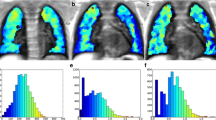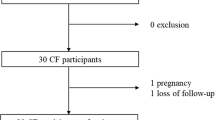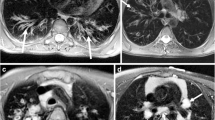Abstract
Background
Assessment tools for early cystic fibrosis (CF) lung disease are limited. Detecting early pulmonary disease is crucial to increasing life expectancy by starting interventions to slow the progression of the pulmonary disease with the many treatment options available.
Objective
To compare the utility of lung T1-mapping MRI with ultrashort echo time (UTE) MRI in children with cystic fibrosis in detecting early stage lung disease and monitoring pulmonary exacerbations.
Materials and methods
We performed a prospective study in 16 children between September 2017 and January 2018. In Phase 1, we compared five CF patients with normal spirometry (mean 11.2 years) to five age- and gender-matched healthy volunteers. In Phase 2, we longitudinally evaluated six CF patients (median 11 years) in acute pulmonary exacerbation. All children had non-contrast lung T1-mapping and UTE MRI and spirometry testing. We compared the mean normalized T1 value and percentage lung volume without T1 value in CF patients and healthy subjects in Phase 1 and during treatment in Phase 2. We also performed cystic fibrosis MRI scoring. We evaluated differences in continuous variables using standard statistical tests.
Results
In Phase 1, mean normalized T1 values of the lung were significantly lower in CF patients in comparison to healthy controls (P=0.02) except in the right lower lobe (P=0.29). The percentage lung volume without T1 value was also significantly higher in CF patients (P=0.006). UTE MRI showed no significant differences between CF patients and healthy volunteers (P=0.11). In Phase 2, excluding one outlier case who developed systemic disease in the course of treatment, the whole-lung T1 value increased (P=0.001) and perfusion scoring improved (P=0.02) following therapy. We observed no other significant changes in the MRI scoring.
Conclusion
Lung T1-mapping MRI can detect early regional pulmonary CF disease in children and might be helpful in the assessment of acute pulmonary exacerbations.





Similar content being viewed by others
References
Sly PD, Brennan S, Gangell C et al (2009) Lung disease at diagnosis in infants with cystic fibrosis detected by newborn screening. Am J Respir Crit Care Med 180:146–152
Long FR, Williams RS, Castile RG (2004) Structural airway abnormalities in infants and young children with cystic fibrosis. J Pediatr 144:154–161
Mott LS, Park J, Murray CP et al (2012) Progression of early structural lung disease in young children with cystic fibrosis assessed using CT. Thorax 67:509–516
Cystic Fibrosis Foundation (2016) 2016 patient registry annual data report. https://www.cff.org/Research/Researcher-Resources/Patient-Registry/2016-Patient-Registry-Annual-Data-Report.pdf. Retrieved 25 Jan 2020
de Jong PA, Nakano Y, Lequin MH et al (2004) Progressive damage on high resolution computed tomography despite stable lung function in cystic fibrosis. Eur Respir J 23:93–97
de Jong PA, Lindblad A, Rubin L et al (2006) Progression of lung disease on computed tomography and pulmonary function tests in children and adults with cystic fibrosis. Thorax 61:80–85
Nasr SZ, Kuhns LR, Brown RW et al (2001) Use of computerized tomography and chest X-rays in evaluating efficacy of aerosolized recombinant human DNase in cystic fibrosis patients younger than age 5 years: a preliminary study. Pediatr Pulmonol 31:377–382
Nasr SZ, Gordon D, Sakmar E et al (2006) High resolution computerized tomography of the chest and pulmonary function testing in evaluating the effect of tobramycin solution for inhalation in cystic fibrosis patients. Pediatr Pulmonol 41:1129–1137
Maffessanti M, Candusso M, Brizzi F, Piovesana F (1996) Cystic fibrosis in children: HRCT findings and distribution of disease. J Thorac Imaging 11:27–38
Byrnes CA, Vidmar S, Cheney JL et al (2013) Prospective evaluation of respiratory exacerbations in children with cystic fibrosis from newborn screening to 5 years of age. Thorax 68:643–651
Horsley AR, Davies JC, Gray RD et al (2013) Changes in physiological, functional and structural markers of cystic fibrosis lung disease with treatment of a pulmonary exacerbation. Thorax 68:532–539
Wielpütz MO, von Stackelberg O, Stahl M et al (2018) Multicentre standardisation of chest MRI as radiation-free outcome measure of lung disease in young children with cystic fibrosis. J Cyst Fibros 189:956–965
Kanda T, Ishii K, Kawaguchi H et al (2014) High signal intensity in the dentate nucleus and globus pallidus on unenhanced T1-weighted MR images: relationship with increasing cumulative dose of a gadolinium-based contrast material. Radiology 270:834–841
Kanal E, Tweedle MF (2015) Residual or retained gadolinium: practical implications for radiologists and our patients. Radiology 275:630–634
Jakob PM, Wang T, Schultz G et al (2004) Assessment of human pulmonary function using oxygen-enhanced T(1) imaging in patients with cystic fibrosis. Magn Reson Med 51:1009–1016
Dasenbrook EC, Lu L, Donnola S et al (2013) Normalized T1 magnetic resonance imaging for assessment of regional lung function in adult cystic fibrosis patients — a cross-sectional study. PLoS One 8:e73286
Donnola SB, Dasenbrook EC, Weaver D et al (2017) Preliminary comparison of normalized T1 and non-contrast perfusion MRI assessments of regional lung disease in cystic fibrosis patients. J Cyst Fibros 16:283–290
Tiddens HA, Donaldson SH, Rosenfeld M, Pare PD (2010) Cystic fibrosis lung disease starts in the small airways: can we treat it more effectively? Pediatr Pulmonol 45:107–117
Sommer N, Dietrich A, Schermuly RT et al (2008) Regulation of hypoxic pulmonary vasoconstriction: basic mechanisms. Eur Respir J 32:1639–1651
Schraml C, Schwenzer NF, Martirosian P et al (2012) Non-invasive pulmonary perfusion assessment in young patients with cystic fibrosis using an arterial spin labeling MR technique at 1.5 T. Magma 25:155–162
Roach DJ, Cremillieux Y, Fleck RJ et al (2016) Ultrashort echo-time magnetic resonance imaging is a sensitive method for the evaluation of early cystic fibrosis lung disease. Ann Am Thorac Soc 13:1923–1931
Goss CH, Edwards TC, Ramsey BW et al (2009) Patient-reported respiratory symptoms in cystic fibrosis. J Cyst Fibros 8:245–252
Goss CH, Caldwell E, Gries KS et al (2013) Validation of a novel patient reported respiratory symptoms instrument in cystic fibrosis: CFRSD-CRISS. Pediatr Pulmonol S36:251
Kellman P, Arai AE, Xue H (2013) T1 and extracellular volume mapping in the heart: estimation of error maps and the influence of noise on precision. J Cardiovasc Magn Reson 15:56
Eichinger M, Optazaite DE, Kopp-Schneider A et al (2012) Morphologic and functional scoring of cystic fibrosis lung disease using MRI. Eur J Radiol 81:1321–1329
Edelman RR, Hatabu H, Tadamura E et al (1996) Noninvasive assessment of regional ventilation in the human lung using oxygen-enhanced magnetic resonance imaging. Nat Med 2:1236–1239
Ailion DC, Ganesan K, Kanert O et al (1996) Nuclear magnetic resonance: basic principles. In: Cutillo AG (ed) Application of magnetic resonance to the study of lung. Futura, New York, pp 1–31
Li Z, Sanders DB, Rock MJ et al (2012) Regional differences in the evolution of lung disease in children with cystic fibrosis. Pediatr Pulmonol 47:635–640
Wielpütz MO, Puderbach M, Kopp-Schneider A et al (2014) Magnetic resonance imaging detects changes in structure and perfusion, and response to therapy in early cystic fibrosis lung disease. Am J Respir Crit Care Med 189:956–965
Thomen RP, Walkup LL, Roach DJ et al (2017) Hyperpolarized (129)Xe for investigation of mild cystic fibrosis lung disease in pediatric patients. J Cyst Fibros 16:275–282
Ramalho J, Semelka RC, Ramalho M et al (2016) Gadolinium-based contrast agent accumulation and toxicity: an update. AJNR Am J Neuroradiol 37:1192–1198
Acknowledgments
The authors thank Christian Stehning of Philips Healthcare for support with the T1-mapping sequence.
Author information
Authors and Affiliations
Corresponding author
Ethics declarations
Conflicts of interest
None
Additional information
Publisher’s note
Springer Nature remains neutral with regard to jurisdictional claims in published maps and institutional affiliations.
Rights and permissions
About this article
Cite this article
Neemuchwala, F., Ghadimi Mahani, M., Pang, Y. et al. Lung T1 mapping magnetic resonance imaging in the assessment of pulmonary disease in children with cystic fibrosis: a pilot study. Pediatr Radiol 50, 923–934 (2020). https://doi.org/10.1007/s00247-020-04638-9
Received:
Revised:
Accepted:
Published:
Issue Date:
DOI: https://doi.org/10.1007/s00247-020-04638-9




